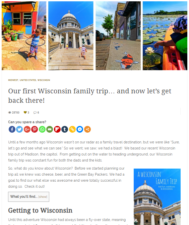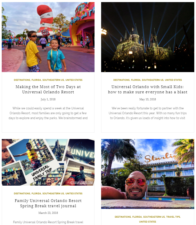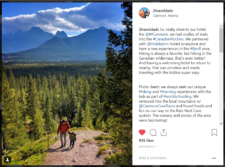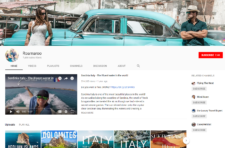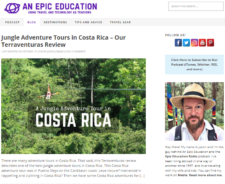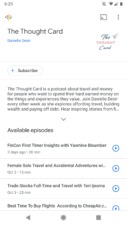Welcome to part three of Building Blogger and Influencer Marking Partnerships. So far we’ve covered what an influencer actually is and what value there is to building a partnership. We’ve addressed why and how to create a budget for influencer marketing, including cost distribution. And now it’s time for committing to the plunge into and creating influencer marketing plans. This is the second step in building influencer partnerships: adopting a new mindset and a bright marketing horizon.
Pre-work: understanding WHY you are considering influencer marketing
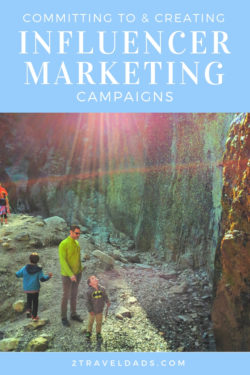 If you’ve made it this far, you have an idea of the value and impact influencer marketing can have. Before you fully dive in though, you need to understand and get your team on board with your goals in pitching to an influencer for a campaign. You need to have an idea of what you want and the aim of creating influencer marketing plans.
If you’ve made it this far, you have an idea of the value and impact influencer marketing can have. Before you fully dive in though, you need to understand and get your team on board with your goals in pitching to an influencer for a campaign. You need to have an idea of what you want and the aim of creating influencer marketing plans.
Are you going to pitch to an influencer out of peer pressure or because somebody told you it’s what all the cool kids are doing? Are you at wits end in your journey to broaden your customer base? Are you just tired of traditional marketing and the hopeful impression a highway billboard might make? All of these are good reasons to learn how to pitch to an influencer and to create compelling influencer marketing plans, but unless you yourself are sold on the idea and committed to making it work, the campaign will be a dud.
We’re going to figure this out together and get to the bottom of WHY you are moving towards influencer marketing. We’re going to use the example of hot sauce and cooking to get to the bottom of it.
Peer pressure to change your marketing strategies
You traditionally enjoy soup for lunch, but it’s just lost its flare and you feel like the health benefits and cost savings of soup just aren’t worth it anymore. Your buddy sits down to chat during lunch and says “If you’re bored with your soup, why don’t you spice it up a bit. Add a little Frank’s Red Hot and you’ll like it, I bet.” So you add just a little of Frank’s Red Hot and take a couple of bites. You see that there’s a new complexity to your soup and the dash of heat is a bit exciting.
While a good deal of peer pressure in life is bad, there are good types too. If your colleagues are repeatedly telling you that they’ve had success by changing from X to Y and you should too, maybe you should listen. Thinking about the soup analogy, that buddy may have tried some other types of hot sauce before landing on Frank’s as the winner for him. When somebody has a success, or a favorite hot sauce, they’re typically more than willing to share a bit about their journey and why they are recommending a change. Pick their brain and be open to hearing why they feel the way they do.
Tip: just like not every hot sauce is right for everybody, not every niche of influencer or campaign style is right for every product or brand. Don’t jam a square peg into a round hole.
Changing to reach a new customer base
The world is tired of soup. It’s everywhere and they’re numb to it. Nobody pays attention to your soup when you bring it to the office potluck. You know that your soup is great to warm up the soul and nourish the body… but people don’t dig it like they used to. So you jump online and see what’s new in cooking news and restaurant trends. You discover pho for the first time… and it’s very similar to the type of soup you already make, but it has some jalapenos on the side and often is served with chili paste or sriracha. You take your cue from the trending successes and bring your same soup with some nice condiments and make the experience of soup interesting. People who’ve never tried your soup are intrigued and add some fixings. They love it.
Same thing goes with reaching a new customer base. You’ve got a solid product or brand that is great and really meets the needs of customers, but there are newer options or people have just forgotten that they liked what you offer. Change up your approach and work with an influencer to share your brand with THEIR network and boom: you’ve got a new potential customer base. If you aren’t sure how to create influencer marketing campaigns that will be a good fit with your brand, scour the web and social media to see who’s featuring or using products in the same genre… or is already your customer. You’ll revive the recognition of your product and garner fresh eyes.
Tip: many bloggers and influencers tag brands and products in social media when they’re featuring them, whether it’s a paid marketing campaign or not. See who’s actively giving shout outs and is already a spokesperson for your brand. They’re already an authentic voice for you so creating influencer marketing with them could be a breeze.
The old way isn’t working for you
Accepting that your traditional soup recipe just doesn’t get eaten up at parties anymore is the first step to finding a new dish that inspires conversation. You decide you’re done making chicken noodle soup; you’re going to make chili with cornbread. You taste it and the preview is good, but you need something else to really make a splash. You go to the farmers market and buy a seasoning blend from a local farmer who is the talk of the stalls. You add the seasoning to your chili and it’s good to go. “Wow! I didn’t know you could make such a delicious dish! Bravo! Can I have the recipe?”
If you’ve seen either traditional advertising campaigns have no return or worse, create a negative impression of your product or brand, then you know it’s time to figure out what’s going to work better. Accepting a new process and point of view is the first step to a new methodology. Being in a good mental place about your brand and goals is something you need and will help you create an influencer marketing plan that supports your ideas or needs.
Tip: as you start creating influencer marketing plans and launching them, let there be active discussion about the process and own it. Until a work group has seen the benefits, either in CTR or increased engagement in another form, they may not see the big picture and value of the campaign/campaigns.
Creating Influencer Marketing Plans
Now that you understand why you’re moving into working with bloggers and influencers, the next part is to create influencer marketing plans. This is going to look different for every brand or business. We’ve done influencer campaigns that are as basic as creating an individual blog post and we’ve done campaigns that include long form written blog content, live social media activations, event participation, Twitter chats, crafted social media series, video content and more.
When you’re evaluating what sort of marketing you want an influencer to be a part of, you need to consider the following:
- what is the target demographic and where are they MOST ACTIVE?
- is there greater value in static, evergreen content or sensational social media content plans?
- should you be creating influencer campaigns for short terms or planning for potential long term partnerships?
- what does your budget allow for?
Creating influencer marketing plans that are targeted and intentional allows you to more directly influence the content the influencer will be crafting.
Who is your target demographic?
We all want our goods and services to be applicable to everybody, or at least a larger group of people than we already know support our brand. So, how do you select a target demographic as you’re creating influencer marketing plans? These are the four steps to successfully pin down the audience a campaign should capture:
- use current sales tools within your business to determine WHO your CURRENT customer base it
- research your direct competitors and glean what you can from social media and web content about WHO is USING or SHARING their product
- critically look at the difference between these two groups and see where you’re currently missing the mark
- broaden your research and find another target group that is drastically different from your current customer base but clearing engages with a product or brand that is VERY SIMILAR to your own
Reviewing your current customer base vs other potential customers gives you great insight into the lifestyle and spending abilities of everyone you may want to target your influencer marketing campaign towards.
When you have hammered out your target demographic, you can start planning what sort of content you think will get the greatest response or the most engagement.
Types of Influencer Marketing Content
If your target demographic is a part of the Instagram generation, are you going to create an influencer marketing plan that’s focuses on podcasts and YouTube content, or are you going to make a plan that’s all about Instagram stories and static content? If you want to appeal to a customer base that statistically engages with consumer product blogs and actively writes reviews, are you going to plan a media event or Instagram worth cocktail party?
Blog Content
Blog content is a favorite when creating influencer marketing plans, as it’s favored by Google if the SEO is properly executed and it can be crafted to be evergreen. Evergreen content that links back to a brand or product is a great way to build a strong online presence that’s searchable long after the initial influencer marketing campaign has wrapped up. Brand ambassadorships are a great approach to generating evergreen content.
Blog content also is shareable. How many times do you as a user jump onto Facebook and see one of your friends has shared a blog posts about something, whether a product, destination or social issue? All the time. Partnering with a blogger that’s skilled in evergreen content creation is a great investment of your influencer marketing budget as it has long term value.
Note: most bloggers also are active across all social media platforms, so creating influencer marketing plans that takes the social presence into account is smart planning.
Instagram Posts and Stories
Anybody can create an Instagram account and post whatever sort of images and stories they want about anything. Engaging an Instagram influencer for a campaign is, I feel, a bigger risk than any other type of influencer. Why? Here are the primary risks of focusing on an Instagram influencer campaign:
- Live engagement is difficult to manage in terms of the content produced/approved
- Static content can produce CTR but there are multiple steps a user must go through to click through to a link or brand profile
- Instagram influencers with exorbitant numbers of followers or unrealistic levels of engagement are often working the system, sometimes in an unethical way
- This is a big statement, I know, but it is often the case. There are ethical ways to garner great numbers of followers and engagement too, but a little digging around and genuine engagement becomes clear. Check out this article from Forbes that totally agrees with me.
- Getting a team to stand behind an influencer campaign living primarily on one platform is an uphill battle that’s easy to regret
Having said all that, there is definite value to including Instagram when you create an influencer marketing plan. The content has the potential to be seen by all sorts of users depending on trending hashtags and other related content gaining momentum on the platform.
YouTube Videos
Creating an influencer marketing plan with a strong YouTube or video content element is a very specialized approach to take. Influencers with a large YouTube following have figured out the magic skill of creating compelling visual AND story content that viewers don’t click away from easily. Whether it’s because they are able to show a captivating perspective of a activity or destination or because they can weave personality into an informative presentations, a video-based influencer can hold a lot of value for a campaign.
If this is the route you would like to go, make sure it fits with the product or brand you’re trying to promote. Video reviews and highlight reels are easy to share across multiple platforms. If you’re creating an influencer marketing plan that involves video, be sure to incorporate a call to action (CTA) in the campaign scripting so you don’t lose that captive audience before they’ve moved onto the next shiny video in their feed.
Featured below: Roamaroo‘s YouTube channel, video project we did with T-Mobile, and Steps of 2 Foreigners YouTube channel
Podcast Episodes
Much like working with a video influencer, a podcaster has a very niche skill set. When you consider engaging with a podcaster, you open your campaign content to reaching an entirely different audience and crossing platforms that other types of influencer aren’t even on. A podcast is available via websites, iTunes and Google Play Music. There are Roku and Fire channels that can pull podcast content. Amazing how you’ve just potentially tapped into media streams you never even gave a second thought to!
Another benefit to working with a podcaster is that as they create their audio content, they most often will often either transcribe the entirety of their podcast or will make detailed show notes available. This is a chance to work evergreen SEO friendly content into your influencer marketing plan.
Featured below: An Epic Education podcast and The Thought Card podcast. Both feature audio content across multiple platforms and strong SEO based written content to supplement podcast segments.
This all sounds very doable, doesn’t it? It is! Getting a solid understanding of why you want to start into influencer marketing and then thoughtfully creating an influencer marketing plan will ensure that you can begin with confidence and have success.
Please, if you have any questions or feedback about our course on Building Blogger and Influencer Marketing Partnerships, please send us a note or leave a comment. We’re happy to help, either as a resource or to be involved in creating and launching campaigns.

